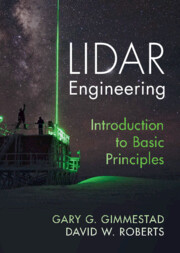Book contents
- Lidar Engineering
- Lidar Engineering
- Copyright page
- Dedication
- Contents
- Preface
- Glossary
- List of Abbreviations
- 1 Introduction
- 2 The Basic Lidar Models
- 3 The Molecular Atmosphere
- 4 Particles in the Atmosphere
- 5 Lidar Transmitters
- 6 Lidar Receivers and the Geometrical Function
- 7 Optomechanics
- 8 Optical Detection
- 9 Data Systems
- 10 Lidar Data Analysis
- 11 Applications
- Appendix A The Klett Retrieval
- Index
- References
4 - Particles in the Atmosphere
Published online by Cambridge University Press: 16 February 2023
- Lidar Engineering
- Lidar Engineering
- Copyright page
- Dedication
- Contents
- Preface
- Glossary
- List of Abbreviations
- 1 Introduction
- 2 The Basic Lidar Models
- 3 The Molecular Atmosphere
- 4 Particles in the Atmosphere
- 5 Lidar Transmitters
- 6 Lidar Receivers and the Geometrical Function
- 7 Optomechanics
- 8 Optical Detection
- 9 Data Systems
- 10 Lidar Data Analysis
- 11 Applications
- Appendix A The Klett Retrieval
- Index
- References
Summary
The range of atmospheric scattering particle sizes is compared graphically with the range of wavelengths used in lidar to show that common particles are both much smaller and much larger than the wavelengths. Scattering must therefore be considered in all three regimes, so formulations and important results are described for Rayleigh, Mie, and geometric optics scattering. Aerosols in the troposphere and stratosphere are then described, with sources, sinks, and size ranges. The lidar ratio is defined. Other particle types are found in water and ice clouds, polar stratospheric clouds, and noctilucent clouds. Depolarization by nonspherical particles is described with Stokes vectors and Mueller matrices, and algorithms are given for finding the degree of depolarization from lidar measurement data. Particle classifiers are described, with examples, illustrating classification techniques using lidar ratios, depolarization ratios, and color ratios. The theory of sun photometry is then reviewed, and AERONET data products are described, with examples.
Keywords
- Type
- Chapter
- Information
- Lidar EngineeringIntroduction to Basic Principles, pp. 65 - 112Publisher: Cambridge University PressPrint publication year: 2023

